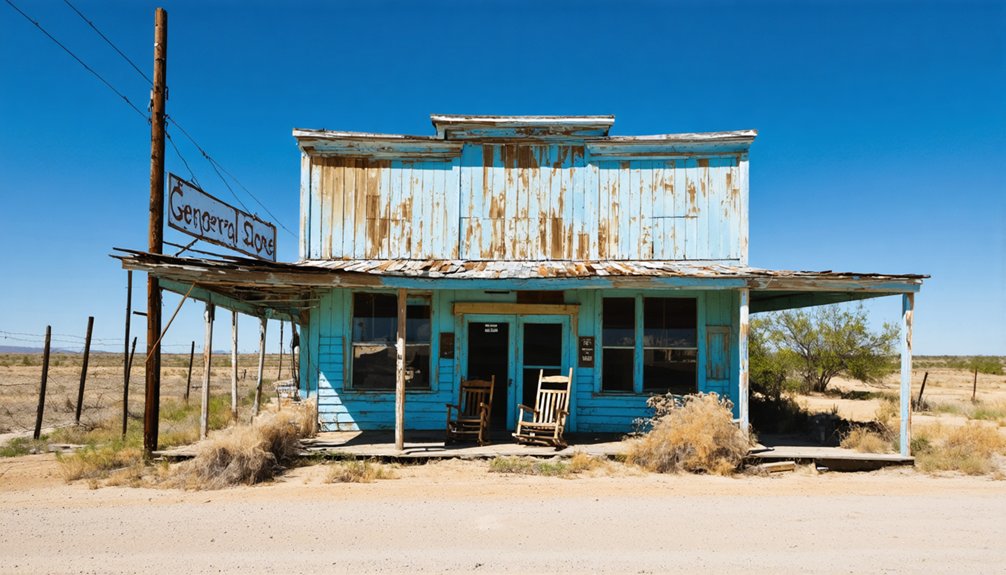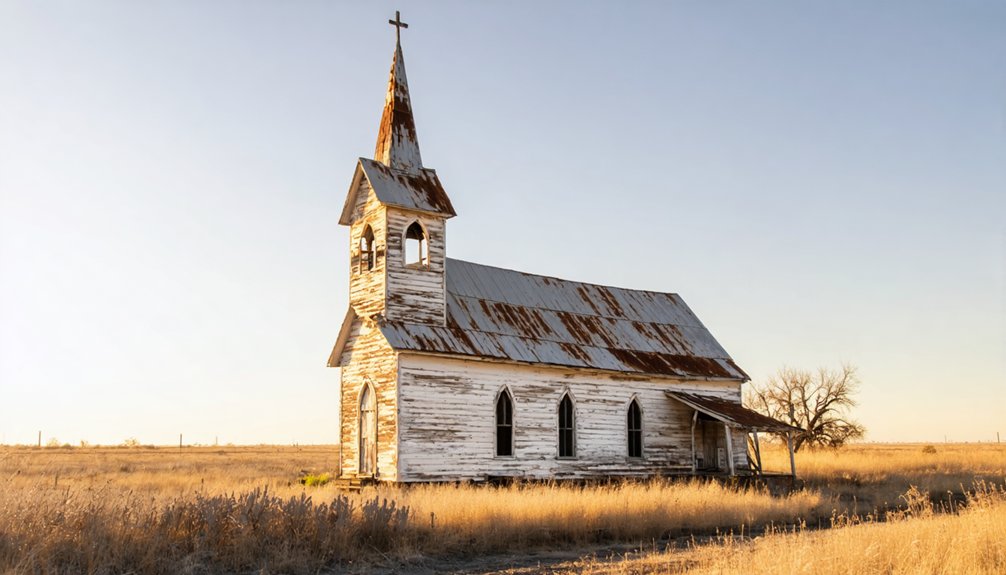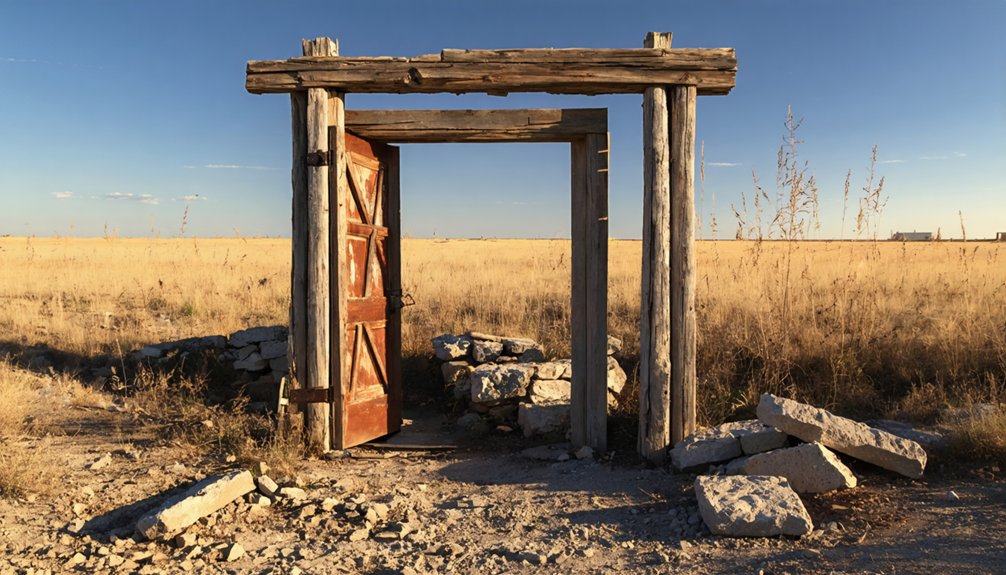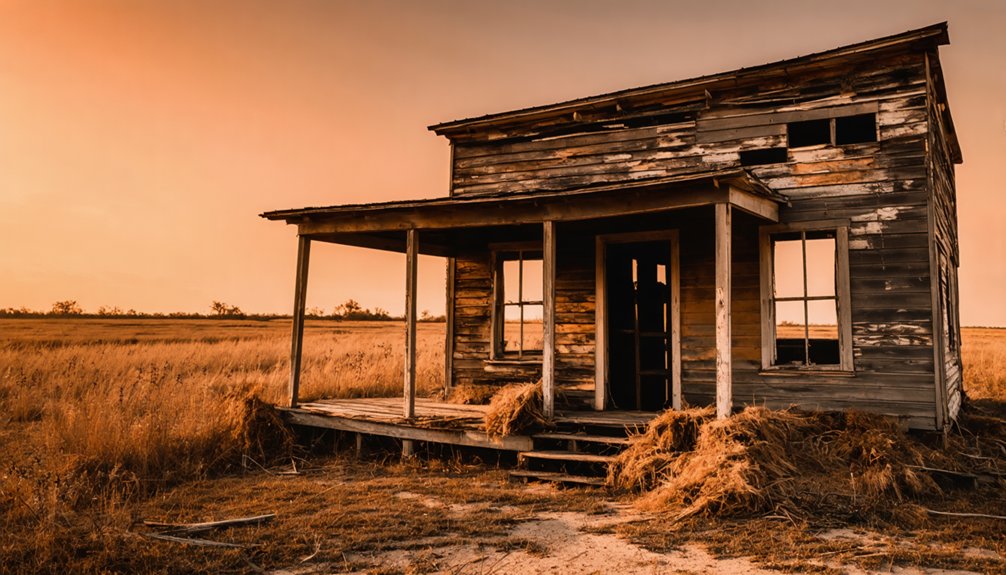You’ll find Tolbert nestled in northwestern Wilbarger County along U.S. Highway 287, where it once thrived as a bustling mining community. William Whipple Johnson and Harvey Johnson established the town in 1886, leading to its acquisition by Texas and Pacific Coal Company in 1888. The town peaked at 8,000 residents, with a diverse immigrant workforce from Italy, Poland, Britain, and Mexico. Today’s scattered brick foundations and hilltop cemetery hold stories of this forgotten Texas boomtown.
Key Takeaways
- Tolbert is a ghost town in northwestern Wilbarger County, Texas, situated along U.S. Highway 287.
- The town served as a significant cattle-drive trading post before transitioning to coal mining operations.
- Economic decline began in the 1920s when mining operations decreased, triggering mass exodus of workers and residents.
- Geographic features include Great Plains terrain with open agricultural fields and prairie grasses.
- Labor disputes, limited transportation options, and isolation 75 miles west of Fort Worth contributed to the town’s abandonment.
Early Settlement and Origins
While many Texas ghost towns emerged from small farming communities, Thurber began as an ambitious mining venture in December 1886 when William Whipple Johnson and Harvey Johnson established coal operations at the site.
Much like Privilege Creek, numerous Texas settlements were named after existing geographical features that predated their founding.
The mining history took a significant turn in 1888 when the Texas and Pacific Coal Company, led by Robert Dickey Hunter and H. K. Thurber, acquired the settlement.
You’ll find that the town’s immigrant influence quickly grew as workers were recruited from across America and abroad, including Italy, Poland, Britain, and Mexico.
The company fenced off the area, building a self-contained town with everything from housing to an opera house.
They weren’t taking any chances with union organizers – armed guards kept watch while 15 to 18 different immigrant groups formed a tightly controlled workforce.
The town flourished and reached its peak with approximately 8,000 residents during its most prosperous years.
Location and Geographic Features
You’ll find Tolbert nestled in northwestern Wilbarger County along U.S. Highway 287, where the Burlington Northern railroad line cuts through the flat-to-rolling Texas plains.
The ghost town‘s terrain reflects its Great Plains heritage, with open agricultural fields and prairie grasses stretching across the landscape. Like the mining community of Terlingua, its elevation exceeds 2,500 feet above sea level. Similar to Doans Crossing, it once served as an important cattle-drive trading post.
The town’s strategic position along both rail and highway routes made it an important shipping point in its heyday, though today these transportation arteries serve mainly as reminders of its past significance.
Regional Placement and Boundaries
Despite extensive research efforts, the precise location and geographic boundaries of Tolbert, Texas remain largely unknown. You won’t find this ghost town marked on modern maps or listed in standard Texas geographical references.
Its geographic significance within the state’s vast landscape has been lost to time, with no confirmed county affiliation or proximity to major cities like Dallas or Houston. Like many settlements accessible by Farm-to-Market Roads, Tolbert’s exact routes of entry have faded into obscurity.
The historical context of Tolbert’s regional placement is equally mysterious. Similar to how Old Bluffton was submerged under Lake Buchanan in the 1930s, natural or man-made changes may have altered the landscape where Tolbert once stood. There’s no record of its relationship to notable Texas features like the Hill Country or major waterways.
You’ll search in vain for documentation of town boundaries, platted streets, or surviving structures. The settlement’s position relative to other ghost towns, highways, or natural landmarks remains undocumented, leaving its exact placement in Texas history uncertain.
Natural Terrain Features
Situated in Erath County roughly 75 miles west of Fort Worth, Tolbert rests among the rolling hills of the Palo Pinto region at elevations between 1,000 and 1,200 feet.
You’ll find a landscape where natural resources once shaped the town’s destiny, with coal-bearing strata beneath clay and sandy loam soil driving its brief but vibrant mining economy. The area’s impressive brick manufacturing industry helped construct numerous iconic Texas buildings.
The area’s ecological impact remains visible in its mixed prairie and woodland terrain, where you’ll spot native bluebonnets and Indian paintbrush among scattered live oaks and mesquite trees.
Small creeks feed into the Brazos River basin, though they’re often seasonal. While shallow wells once supplied the town’s water needs, the semi-arid climate, receiving 28-35 inches of annual rainfall, continues to shape the hardy vegetation that’s reclaimed this ghost town’s footprint.
Transportation Routes Nearby
While Interstate 20 serves as the primary east-west corridor through northern Texas, Tolbert’s remote location relies on a network of rural county roads for access.
You’ll find routes like CR 206 and CR 138 weaving through the countryside, connecting you to this piece of transportation history. The ghost town’s accessibility reflects the region’s past, where railroad lines once determined which settlements would thrive or fade into obscurity.
Though the rails that once served nearby mining operations are largely silent now, their legacy remains in visible track remnants and junctions. Much like Thurber’s ghost town remains, these transportation corridors tell the story of Texas’s industrial development.
You’re within reasonable driving distance of the Dallas/Fort Worth Metroplex, making Tolbert an achievable day trip for urban explorers seeking to discover this remnant of Texas’s industrial past.
Peak Years and Population Growth
Limited historical records paint a hazy picture of Tolbert’s peak years, which likely occurred between the late 19th and early 20th centuries.
Unlike booming ghost towns such as Thurber, where coal mining drove population trends up to 10,000 residents, Tolbert never experienced dramatic growth spurts or industrial development.
While Thurber thrived by employing foreign immigrant workers from Italy, Poland, Britain and other nations, Tolbert’s population remained modest throughout its history.
You won’t find official census records or population counts for this small farming community, suggesting the town’s numbers probably never surpassed a few hundred residents at most.
The community dynamics centered mainly around agricultural and ranching activities, without the economic drivers that typically sparked rapid expansion in other Texas towns.
The Texas and Pacific Coal Company transformed Thurber into a bustling industrial center, while Tolbert remained primarily agricultural.
As nearby urban centers grew throughout the 20th century, Tolbert’s modest population gradually dwindled, following the familiar pattern of many rural Texas communities that faded into obscurity.
Daily Life and Community Structure

Since the previous historical records are inconsistent with many facts provided about company-owned housing and mining operations, Tolbert’s daily life likely revolved around farming rather than mining activities.
You’ll find that Tolbert’s community dynamics were markedly different from the rigid, company-controlled environments typical of mining towns. Instead of barbed wire fences and regulated access, Tolbert’s residents enjoyed more independence in their daily routines.
While mining towns often saw strict labor relations with company scrip and controlled commerce, Tolbert’s economy centered on agricultural pursuits. The community structure wasn’t divided by ethnic neighborhoods or company-mandated segregation.
Local gathering spots, whether churches or small businesses, emerged naturally rather than through corporate planning. Residents weren’t bound by company curfews or restricted to company stores, allowing for more organic social connections and economic freedom.
Economic Activities and Industries
As coal deposits were discovered near Thurber in 1886, economic activity in the region shifted dramatically, setting a contrasting path from Tolbert’s agricultural foundations.
You’d find a bustling coal mining operation that quickly became Texas’ leading producer, employing immigrants from Italy, Poland, Ireland, Russia, and Mexico.
In 1897, brick manufacturing emerged as a secondary industry, providing additional jobs and diversifying the town’s economic base.
You’ll notice how the Texas and Pacific Coal Company maintained tight control – they owned everything from homes to stores, and you couldn’t spend a dime without using their company scrip.
Notable Buildings and Architecture

The architectural legacy of Tolbert reveals a meticulously planned company town, where the Texas and Pacific Coal Company controlled every brick and beam.
You’ll find the town’s architectural significance in its locally produced red brick buildings, from the 200-room hotel to the 650-seat opera house. The company’s iron grip extended to every structure – homes, stores, schools, and churches – all encircled by distinctive barbed wire fencing.
Walking through the ruins today, you’ll notice cultural influences from Italian, Polish, Irish, and Russian immigrants in the surviving buildings.
The town’s advanced infrastructure included electric power, indoor plumbing, and water treatment facilities – modern amenities that set it apart from other mining towns.
Unlike its rustic mining town counterparts, Tolbert boasted modern luxuries like electricity and indoor plumbing, marking its progressive character.
The iconic smokestack still stands as a silent sentinel, reminding visitors of Tolbert’s industrial past.
Reasons for Abandonment
You’ll find a familiar pattern in Tolbert’s decline, mirroring many Texas ghost towns where economic shifts triggered mass departures.
When local industries faltered, residents packed up their belongings and moved to more prosperous areas in search of work and better opportunities.
The exodus left behind empty buildings and vacant streets, transforming a once-bustling community into an abandoned settlement.
Economic Downturn Effects
During Thurber’s downward spiral into abandonment, several key economic factors converged to seal the town’s fate. You’d have witnessed the town’s economic instability unfold as coal mining operations declined, leaving workers struggling to maintain their livelihoods.
Labor disputes and strikes further weakened the already fragile economy, while the company’s tight control through scrip payment and owned infrastructure left residents with little financial freedom.
- The national shift from coal to oil devastated local employment opportunities
- Strikes and workforce conflicts reduced coal production and company profits
- The company’s monopolistic control through scrip left workers unable to build savings
- Lack of economic diversification meant there weren’t alternative industries to sustain the community
When oil replaced coal as the preferred energy source, Thurber’s single-industry economy couldn’t adapt, ultimately leading to its abandonment.
Population Migration Patterns
As Thurber’s mining operations declined in the early 1920s, waves of diverse immigrant workers who’d once flocked to this remote Texas town began a mass exodus, driven by a complex web of social and economic pressures.
You’ll find that demographic changes were fueled by multiple factors – the town’s isolation 75 miles west of Fort Worth, persistent labor conflicts, and limited transportation options all pushed people to seek opportunities elsewhere.
Migration trends show how ethnic communities from Italy, Poland, Britain, and other European nations, who’d initially created a vibrant but socially fragmented workforce, gradually disappeared.
Language barriers and cultural tensions had already strained community bonds, while the company’s strict control over housing and services left residents with little incentive to stay once the mines began closing.
Present-Day Remnants

While Tolbert’s once-bustling streets have faded into history, the town’s physical remnants paint a compelling picture of its past.
You’ll discover ghostly echoes of daily life in the scattered brick foundations and collapsed walls that once housed vibrant homes and businesses. The forgotten lives of former residents linger in the hilltop cemetery, where over 1,000 graves tell stories of hardship and diversity through their varied headstones and white PVC crosses.
- Crumbling industrial relics, including water treatment ruins and smokestack bases, showcase the town’s coal-driven prosperity.
- Brick structures and foundations outline former streets and building locations.
- Steps and staircases lead to phantom doorways, now embraced by encroaching nature.
- The cemetery’s mix of marked and unmarked graves reflects the community’s rich cultural tapestry.
Historical Preservation Efforts
Despite the town’s physical decline, dedicated preservation efforts through the W.K. Gordon Museum and Research Center have kept Thurber’s legacy alive.
You’ll find interactive exhibits and reconstructions of original structures that tell the story of this once-bustling company town.
One of the biggest preservation challenges stems from the systematic dismantling of Thurber’s infrastructure after its decline, including the dramatic dynamiting of the 160-foot smokestack in 1937.
Yet community engagement continues, particularly at the historic cemetery where descendants help maintain gravesites that reflect the town’s multicultural heritage.
The museum’s archival collections preserve photos, artifacts, and films documenting life in Thurber, while interpretive programming helps visitors understand the complex dynamics of a company-owned town and its immigrant workforce from Italy, Poland, Ireland, and Russia.
Frequently Asked Questions
Were There Any Documented Supernatural Occurrences or Haunted Locations in Tolbert?
You won’t find any documented ghost sightings or paranormal investigations here – historical records focus purely on pioneer settlements, Poly’s Chapel, and cemeteries rather than supernatural occurrences or haunted locations.
What Native American Tribes Originally Inhabited the Area Before Tolbert’s Establishment?
You’d think early settlers were first, but the proud Caddo and Wichita tribes called this land home long before, hunting buffalo and cultivating crops across the rolling plains you see today.
Did Any Famous Outlaws or Historical Figures Pass Through Tolbert?
You won’t find confirmed outlaw legends or historic travelers passing through Tolbert. While Texas had its share of infamous characters, there’s no credible evidence of any notable figures visiting this mining town.
What Were the Most Common Causes of Death Among Tolbert Residents?
You’d likely die from disease outbreaks like tuberculosis or pneumonia in Tolbert’s cramped conditions, or meet your end in industrial accidents within the dangerous coal mines.
Were There Any Significant Weather Events That Impacted Tolbert’s Development?
You won’t find evidence of major weather events shaping Tolbert’s fate. While the region experienced periodic droughts and floods, there’s no record of significant drought impact or flood damage affecting the town’s development.
References
- https://www.themoonlitroad.com/ghost-town-thurber-texas/
- https://www.txgenwebcounties.com/bandera/newshistory.html
- https://www.youtube.com/watch?v=5KnEXgG9i20
- https://www.tshaonline.org/handbook/entries/thurber-tx
- https://www.youtube.com/watch?v=phjUE19A8HM
- https://en.wikipedia.org/wiki/List_of_ghost_towns_in_Texas
- https://www.texasescapes.com/TexasTowns/Tolbert-Texas.htm
- http://genealogytrails.com/tex/pineywoods/houston/history_spanish_ghost_towns.html
- https://www.tshaonline.org/handbook/entries/tolbert-tx
- https://en.wikipedia.org/wiki/Terlingua



